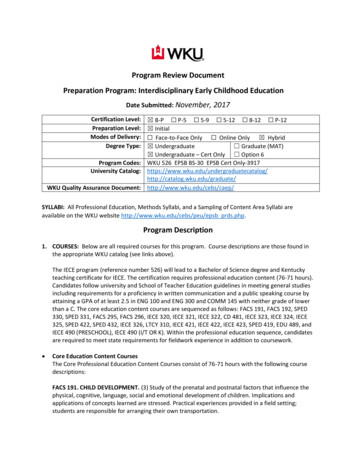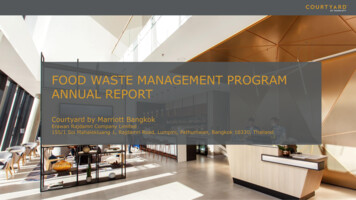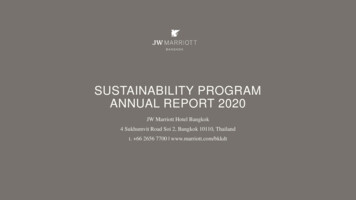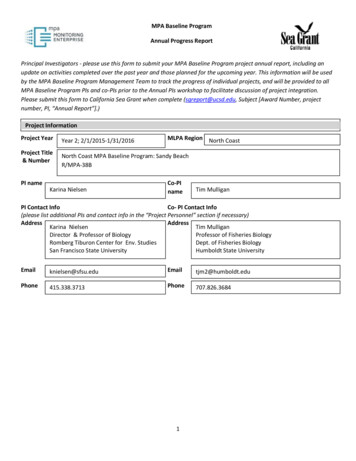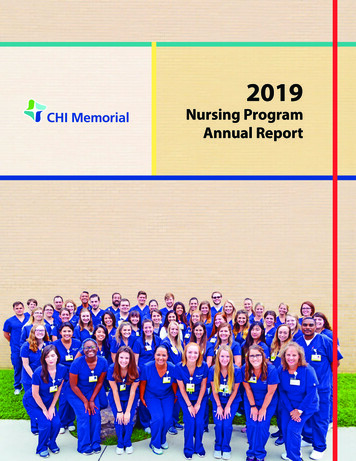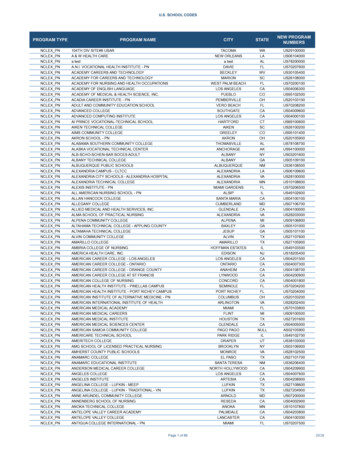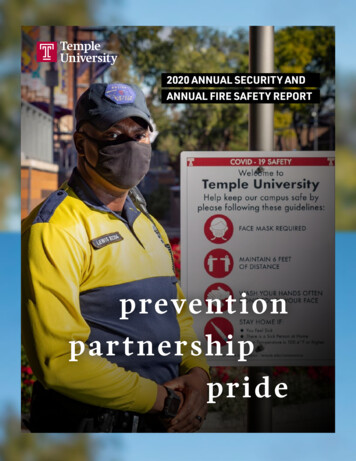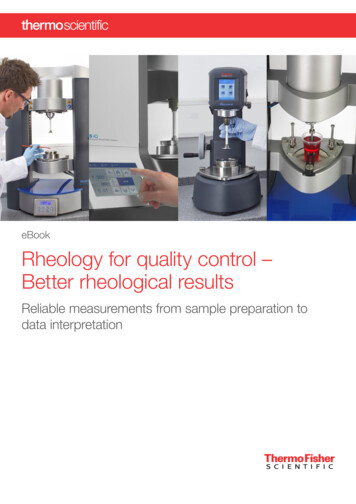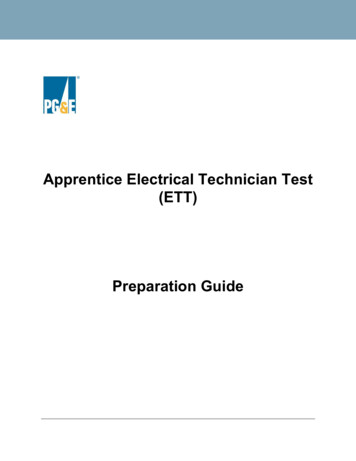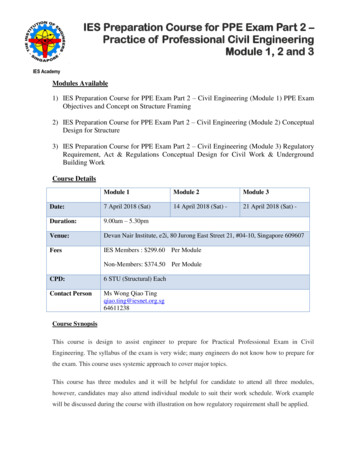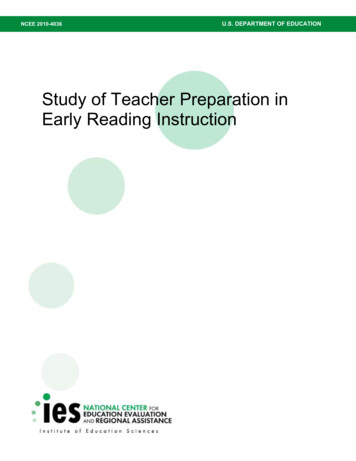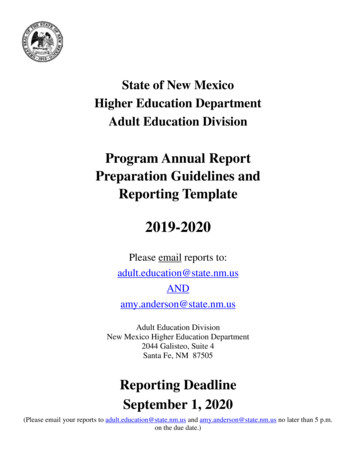
Transcription
State of New MexicoHigher Education DepartmentAdult Education DivisionProgram Annual ReportPreparation Guidelines andReporting Template2019-2020Please email reports e.nm.usAdult Education DivisionNew Mexico Higher Education Department2044 Galisteo, Suite 4Santa Fe, NM 87505Reporting DeadlineSeptember 1, 2020(Please email your reports to adult.education@state.nm.us and amy.anderson@state.nm.us no later than 5 p.m.on the due date.)
Annual Program Report2019-2020Checklist:Complete Cover Page with SignaturesComplete Section I (Program Narrative)Complete Section II (Student Data)Complete Section III (Evaluation of Program Effectiveness)Complete Section IV (WIOA Partner Activities, including Integration with One-Stop Partners)Complete Section V (Career Pathways Activities)Complete Section VI (College and Career Readiness Standards).Complete Section VII (IELCE)Complete Section VIII (Staff and Professional Development).Complete Section IX (Fiscal Survey)Attach all NRS TablesAttach MOUs and IFAsIntroduction:NMHED AE Division provides these guidelines for the Annual Report process for programs to supply 2019-2020program year information. Please take this opportunity to identify areas of program improvement and requesttechnical assistance from NMHED AE. The process also helps the NMHED AE Division to aggregate program
information for reporting to OCTAE at the U.S. Department of Education. Please be sure to contact the NMHEDAE Division with any questions.General Instructions:1. Cover Page2. Annual Report (Sections I – IX).This section includes: Section I (Program Narrative Report) Section II (Student Data) Section III (Evaluation of Program Effectiveness) Section IV (WIOA Partner Activities, including Integration with One-Stop Partners) Section V (Career Pathway Activities) Section VI (College and Career Readiness Standards) Section VII (IELCE Activities) Section VIII (Staff and Professional Development) Section IX (Fiscal Survey)3. Attach all NRS Tables4. Attach MOU and IFA(Please remove these instructional pages when submitting your final report.Your submitted report should begin with the signed cover page.)
Academic & Career EngagementProgram Name: (ACE) CenterInstitution or Organization: San Juan CollegeAddress:City:County:Zip:Main Phone:Fax:Website:3401 East 30th StreetFarmingtonSan ecenterFiscal Year: 2019-2020Submission Date: September 4, 2020Program Director, Manager, orCoordinator Name: Jennifer Martinez-MaestasContact Information:Phone: 505-566-3946Email: martinezj@sanjuancollege.eduErin Carney and VanessaAlternate Contact Names: BedonieContact Information:Phone: 505-566-3488 / 505-566-3270carneye@sanjuancollege.eduEmail: bedoniev@sanjuancollege.eduSignature of the Chief Executive Officer or DesigneeEdward DesPlas, Executive Vice PresidentTyped Name and Title:Section I. Program Narrative ReportDATE
Directions: Answer each of the following questions. As you complete your narrative, include program dataand/or research on which you base these practices as appropriate to answering the questions.Please list your program’s three highest priority goals for the 2019-2020 program year. Discuss your program’sprogress on each of these goals, as well as any additional program year highlights you care to share. If youencountered significant goal-related challenges that were NOT due to the COVID pandemic, please cite themhere; pandemic-related program impacts will be addressed separately in question #4 below.1. Locationa. The ACE Center moved into the new San Juan College 30th St. Education Center. This wasdesigned for high tech classrooms, student engagement, and collaboration with otheragencies.2. Staffa. The ACE Center added a full-time Instructor and Student Advisor to reduce the number ofpart-time instructors needed, increase student support, provide consistency, and promoteyear-round services to students. Adding a full-time Instructor and Student Advisor affordedthe ACE Center students intentional coaching, advising, and direct instruction to increasepersistence and student success.3. Curriculuma. Revised and improved the integrated and accelerated ACE curriculum to meet the demandsof expedient employment or enrollment in post-secondary educationb. Incorporated Labor Market Information (LMI) in two lesson of each 8-week cycle.c. Incorporated social and emotional learning competencies into the ACE Center curriculum toincrease persistence. Student success, and measurable skills gains.d. Incorporated trauma informed teaching and learning practices to increase student support.4. Enrollment practicesa. Adapted onboarding processes to support 8-wee and 4-week cycles. We now offeronboarding and offboarding at 4-weeks to meet the demands of expedient employment orenrollment in post-secondary educationb. Incorporated career pathway selection during the onboarding process5. Technologya. Incorporated 1:1 technology ratio with Chromebooks for each student while in classb. Improved the ACE Center Computer Lab by increasing computersc. Increase testing hours to facilitate students’ schedulesd. Created an online curriculum to meet the needs of COVID-19.6. Classesa. Schedulei. Implemented identical day and evening classes to increase equity as well asaccommodate easier student transfer if neededb. Length of termsi. 8-week and 4-week cycles to deepen learning and accelerate the learning processc. Academic content
i. Fully integrated math, language arts, science, social studies, social and emotionallearning, and digital literacy classes to accelerate student progression and coenrollment opportunitiesd. Industry contenti. Incorporation of LMI website and resources in each 8-week cycleii. Capstone projects based on student pre-selected career pathways to align with postsecondary transition and make project-based learning more relevant to students’career interestse. Employability/soft skills/social and emotional learningi. Woven throughout the learning experience7. Partnershipsa. Preliminary meetings with SL Start leadership to create an apprenticeship and career pathwaypartnershipb. Created co-enrollment opportunities for ACE Center students at San Juan College.8. Professional developmenta. Active Professional Learning Community (PLC) to increase effective teaching practices andbuild capacityDescribe any cooperative arrangements your organization has with other agencies, institutions, or organizationsfor the delivery of adult education and literacy activities. Please specify degree of formality for eacharrangement described (e.g. purely informal agreement vs. MOA/MOU.) How have these collaborationssupported your program’s goals?1. San Juan College is our parent institution and they provide exceptional support to the ACE Center.a. Paid 80-85% salaries of two ACE Center administrative positions.2. Collaboration with partners such as SER Jobs for Progress, Career Link, and the Department ofVocational Rehabilitation (DVR) local offices are progressing slowly. Within these particularentities, staff is scarce, communication is minimal, and collaboration is sporadic. For that veryreason, the ACE Center Director, Jenny Lambert, presented at the Northern Area Local WorkforceDevelopment Board on December 19, 2019 to address these concerns. Jenny Lambert remained anactive board member for much of this fiscal year until her resignation in May 2020.3. Colocationa. The ACE Center is co-located with the Department of Workforce Solutions and the Departmentof Vocational Rehabilitation.Describe your participation in any statewide initiatives and how that participation has affected your program’sgoals. (For example: Justice Initiative, Career Pathways Initiative)1. Career Pathway Initiative (CPI) As a part of the CPI initiative the ACE Center created and improvedall the following items.a. Intensive Coaching and Advising Updatei. Student-centered goals & connectionii. Education, Career, and Life Plansiii. Case managementiv. Realistic case managementv. Wrap-around servicesvi. Transitions to post-secondary and employmentvii. SJC Career Centerb. Integrated, Contextualized, and High Impact Practices (HIP) Curriculum Design and Lesson PlanProcessi. CCRS, ISTE, Social and Emotional Competencies (SEL) aligned
ii. High Impact Practices (HIP)-Training from the BACK of the Room! (TBR), Brain-basedlearning, Universal by Design (UBD), Trauma-informed teaching (TIC) and learning,SEL teaching and learning, Intensive Coaching and Advisingiii. Instructor lesson plan processiv. Curriculum review committeec. Justice-involved Studentsi. Intensive coaching and advisingii. Social and Emotional Competencies (SEL)iii. Trauma-informed teaching (TIC) and learningiv. 1:1 Chromebook ratiov. First-year Experience (FYEX): College credit course at the ACE Center since it is a safeenvironment for them. Taught by ACE Center staff and partners with SJC Humanitiesvi. Current request into SJC leadership to waive tuition and fees or explore Ability to Benefitvii. Partners with SJC Foundation to pay for tuition and feesviii. Transition services provided by Trio, Student Achievement Center, and Advising andCounselingPlease describe the impact of the COVID pandemic on your program. How were goals, timelines, andcollaborative arrangements affected? Describe any substantial changes your program made to both generalservice delivery and to specific policies or procedures, including testing.1. COVID-19 created several barriers for the ACE Center staff and students. These barriers were creatingways to overcome the access to technology, creating an effective virtual instructional design. This iswhere the ACE Center team is deserving of praise. We were agile and adaptive while we recreatedcurriculum, instructional practices, policies, and procedures. Student-centered decision making was ourpriority in maintaining the success of students. I am proud to report that our measurable skill gainswhere only slightly impacted by COVID-19.
Section II. Student Data 2019-2020Please enter the following information regarding student count/hours for: your total program each satellite siteTotalSite:ProgramSJC MainCampusTotal count of students with fewer than 12 hours(Table 2A)Total count of students with 12 hours00Site:30th St.EducationCenter033066264Total contact hours for students with 12 hours285207590.520929.5Average contact hours for students with 12 hours86.42115.0079.28Average contact hours for students with 12 hoursexperiencing level gainsCount of all HSE graduates with 12 hours108.03116.78120.2830030Count of HSE en Español graduates with 12 hours000Post Test Rate ABE (Divide Column B ABE Total ofTable 4b byColumn B ABE Total of Table 4)Post Test Rate ESL (Divide Column B ESL Total ofTable 4b byColumn B ESL Total of Table 4)Percent of ABE students with 12 who separatedbefore achieving MSG (Divide Column G ABE Totalon Table 4 by Column B ABE Total on Table 4)Percent of ESL students with 12 who separatedbefore achieving MSG (Divide Column G ESL Totalon Table 4 by Column B ESL Total on Table 4)71.8222.7284.100007.506.0000Site:Site:Site:
Please indicate your retention rate to 40 hours ormore. (# of ABE students with 40 instructional hoursdivided by Table 4, Column B ABE Total)Please indicate your retention rate to 40 hours ormore. (# of ESL students with 40 instructional hoursdivided by Table 4, Column B ESL Total)Total # of students reportingTRANSPORTATION issues that impact theability to participate in the AE Program.Total # of students reporting CHILD CARE issuesthat impact the ability to participate in the AEProgram.82.1259.1088.630006345943340Please provide a list of communities or organizations requestingservices or additional service from your program.ServiceRequestedJicarilla Apache NationHSEDziłth-Na-O-Dith-HleHSECreative Work SolutionsHSE
Section III. Evaluation of Program EffectivenessIn this section please address program performance and demonstrated effectiveness. Look at thedata for individual sites, as well as for your program as a whole.1. What approaches does your organization currently use to improve performance, and howdoes your organization share promising practices among your program sites?a. The ACE Center integrated curriculumi. The ACE Center curriculum integrates Casel’s Social and EmotionalLearning (SEL) Competencies in every lesson. SEL competencies preparesstudents to grow their interpersonal skills for success in both workplace andpost-secondary arenas.ii. Integrates Trauma Informed Teaching and Learning practicesiii. Integrates digital literacy competencies in addition to integrated contentb. The ACE Center participated in an IET, I-BEST teaching model with theEmergency Medical Technician Program to reduce attrition, increase persistence,impact national registry passing rates.c. The Lead Instructor participated in training for the First Year Experience Seminarcourse (FYEX 1110) to build capacity for ACE students. The outcome was toprovide co-enrollment in the spring semester for students who are ready to transitionto post-secondary. The San Juan College Foundation and some intuitional fundingprovided support for tuition, fees, and books for this cohort of students. 95% ofstudents passed the credit bearing course with an A, obtained their HSE, andpersisted into college.2. When you look at your program data, how effective do you gage your program to be, andwhy? Discuss areas of both strength and challenge, grounding your answer in the data.The ACE Center looks at several data points to determine strengths and opportunities suchas:a. Measurable Skills Gainsi. 74.5%b. HSE Gradatesi. 53 graduatesc. Concurrent Enrollment at San Juan Collegei. 67 studentsd. Social and Emotional Competenciesi. Brain-based and collaborative learning environment and skill building whichis reflected in their class gradese. Summative and Formative Assessmentsi. Checking for understandingf. Retentioni. 82.12%3. When you look at your program data, what noteworthy trends do you see? Anchor youranswer in the data and discuss any action items these observed trends may suggest.a. Retention
i. The retention rates have gradually increased every year for the past eightyears. The ACE Center employs effective strategies to increase andmaintain good retention. ACE staff pay close attention to patterns of exit,students needs and performance, early intervention, intrusive coaching andadvising, and a meaningful student experience. This year the ACE centermaintained a respectable 82.12% retention rate and a 74.5% Table 4.4. Describe any program improvement initiatives you plan to pursue that were not alreadydiscussed in question #3 above.a. Partnership for increased co-enrollment with San Juan Collegeb. Implementing a literacy program that supports HSE attainment, career development,upskilling, and entry into post-secondary education.5. How has your program’s effectiveness been affected by the pandemic? Again, use data tosupport your response.The ACE Center was impacted by the lack of post-testing and final testing due to COVID19 closures.a. Measurable Skills Gainsi. 74.5%ii. Decreased by 3.9% from FY 18-19b. HSE Gradatesi. 53 graduatesii. Decreased by 45 graduatesiii. The SJC Testing Center was closed until mid-June due to COVID-19.c. Concurrent Enrollment at San Juan Collegei. 67 studentsii. Increased by 64 studentsd. Retentioni. 82.12%ii. Decreased by 1.58%Section IV. WIOA Partner Activities, including Integration with One-Stop PartnersFor this section, please describe how the program has provided or supported services in theworkplace development, career, employment and training arena.1. Please provide an estimate of FEDERAL FUNDS used during the2019-2020 fiscal year to support Title I WIOA related activities andservices through the One-Stop system. 300.002. Describe how services provided are aligned with the local workforce development area plan(Section 108 of WIOA), including how concurrent enrollment is promoted in programs andactivities under the Workforce Development Activities (Titles I, III, and IV of WIOA, andas listed in New Mexico’s Combined State Plan). Include information on the activities your
organization provides in response to the regional needs as identified in the local workforcedevelopment area plan under section 108 of title I of WIOA.Collaboration with partners such as SER Jobs for Progress, Career Link, and theDepartment of Vocational Rehabilitation (DVR) local offices are progressing slowly.Within these particular entities, staff is scarce, communication is minimal, andcollaboration is sporadic. For that very reason, the ACE Center Director, Jenny Lambert,presented at the Northern Area Local Workforce Development Board on December 19,2019 to address these concerns. Jenny Lambert remained an active board member for muchof this fiscal year until her resignation in May 2020.3. Describe activities and strategies your organization has implemented to demonstratepartnership with the Local Workforce Development Board (LWDB) and one-stop operatorsto plan, develop, and evaluate adult education and literacy activities for the area you willserve.Collaboration with partners such as HELP NM, DWS, and the Department of VocationalRehabilitation (DVR) local offices are co-located in the 30th St. Education Center at SanJuan College. Our intent is to foster a meaningful and collaborative relationship with thesepartners.4. Include a copy of your program’s MOU and IFA with the Local Workforce Board(s) in thearea(s) in which you provide service. In the event that the MOU or IFA are not complete,please discuss.A new draft is in the works at this time and has been delayed since the State Plan was justrecently approved. The Northern Workforce Board has collaborated to create a simplifiedMOU. This MOU will be executed next FY.
Section V. Career Pathways ActivitiesFor this section, please describe how the program has developed its Career Pathways servicedelivery model and supported related career pathway activities during the 2019-2020 program year.1. Please attach your original Career Pathways Initiative Action Plan final Progress andSustainability Plan to this tXRaUuIzDgDFuLLAHH0SAi/view?usp NTeAF7cWife1kzmjMGWXj7/view?usp sharing2. Describe how your organization’s activities provide learning in context, including throughintegrated education and training (IET)*, so that an individual acquires the skills needed totransition to and complete postsecondary education and training programs, and obtain and advancein employment leading to economic self-sufficiency. *If you offered any IET programs, pleasedescribe how they fulfill the three requirements for an IET program (34 CFR 463)The ACE Center does provide IET courses. The ACE Center’s teaching approach and uniquecurriculum offers intensity and quality, is research-based, best practiced aligned, integratedcontent, and social and emotional learning. This is an opportunity for the ACE Center to grow nextfiscal year.3. If your organization is currently in the process of actively developing any new IETprogramming or is currently working in partnership with another organization or entity to developsuch programming, please describe the nature and status of the effort here.The ACE Center is currently working with the Center for Workforce Development and San JuanCollege to create IET programming for the prioritized sectors.4. If your organization provides formal work-based learning opportunities to your students, or if ithas a collaborative arrangement with another organization or entity to provide such opportunities(or is in the active planning stages of such an effort), please describe those opportunities and/orpartnerships here.Not at this time.Section VI. College and Career Readiness StandardsFor this section, please
State of New Mexico Higher Education Department Adult Education Division Program Annual Report Preparation Guidelines and Reporting Template 2019-2020 Please email reports to: adult.education@state.nm.us AND amy.anderson@state.nm.us Adult Education Division New Mexico Higher Education Department 2
